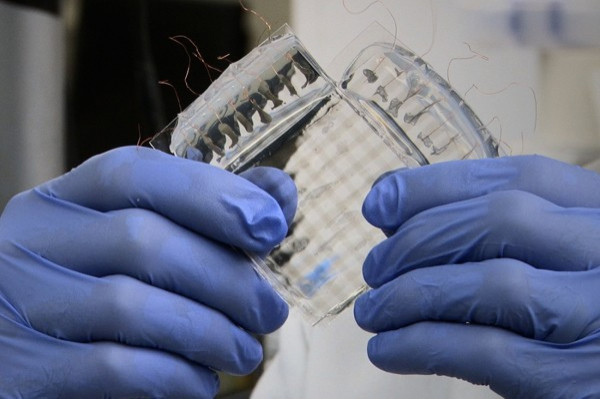Nanotube-Infused ‘Skin’ May Have Application in Robotics, Prosthetics, Computers

Stanford researchers have developed a synthetic skin-like material capable of detecting pressure as well as touch by implementing the use of carbon nanotubes. The research team, led by associate professor of chemical engineering Zhenan Bao, published their work in the journal Nature Nanotechnology.
The "super skin" developed by Bao's team is created by first spraying a film of solution containing single-walled carbon nanotubes over a thin sheet of silicon. The silicon is subsequently stretched along two axes, aligning the bundles of nanotubes into tiny spring-like structures. Once stretched, the two sheets are placed on either side of a third piece of silicon, with the sides coated with the conductive nanotube film facing in, effectively sandwiching the interior silicon sheet. The nanotube-treated sheets are both charged, and when the "skin" as a whole is depressed, the distance between the two sheets - and their surfaces of charged nanotube film - decreases and the ability of the center sheet of silicon to store an electrical charge increases. The system measures the degree by which that ability - or 'capacitance' - is increased and is thereby able to determine how much pressure is being asserted on the skin.
The practical applications of the technology range from uses in computer and mobile devices - flexible mobile phone touchscreens and pressure-sensitive game consoles, for example - to robotics. "One of the long-term applications is to use a stretchable, conformable skin-like device in artificial intelligence systems," said Darren Lipomi, a postdoctoral researcher on Bao's team, in a video interview posted by Stanford. "So, if you have a robot like an android - like Data in Star Trek - his skin could potentially be made out of something like this."
The end goal of the researchers, however, is putting the super skin to use in service of patients requiring prosthetic limbs or skin. Carbon nanotubes are cylindrical structures constructed of one-atom-thick sheets of carbon. Incredibly strong, they are also capable of taking an electric charge, and it is this combination of strength and conductivity that made the carbon nanotubes uniquely suited to use in the area of prosthesis. "This sensor can register pressure ranging from a firm pinch between your thumb and forefinger to twice the pressure exerted by an elephant standing on one foot," said Lipomi in another interview on the university's website.
Though still in the early stages, super skin may well be incorporated into prosthetics in the future. "The ultimate dream of this type of research is to restore functionality to lost skin for amputees, for injured soldiers, for burn victims," said Lipomi. "That's the ultimate goal of this type of science."
© Copyright IBTimes 2024. All rights reserved.





















